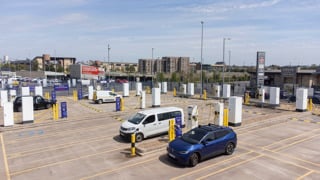By Paul Hollick, managing director of Lightfoot
Huge strides have been made in recent years to bring about decarbonisation on our roads with a firm focus on electric vehicles (EV’s), but are past policies enough, and should the next Government be committing to more radical solutions to help van fleets transition?
The Conservative’s Zero Emissions Mandate has certainly helped to shift the EV adoption needle, as have £9,000 fines for every vehicle that manufacturers fall short of their annual EV van sales targets, but is this enough to encourage mass adoption by fleets right now?
Volume of available vehicles is one thing, but our existing charging infrastructure is a problem. We may have passed 60,000 EV charging points in over 32,000 locations in the UK, but there are still fundamental issues with where these are located, the speed of available chargers, reliable access, and the cost of charging.
Add to this a lack of appetite among van fleets to make the switch early, because the sums of EV ownership simply don’t add up, and it becomes apparent that there is a very real chance that the existing decarbonisation strategy will fail to deliver any meaningful change as far as EV adoption is concerned in the immediate future.
Real world issues
Latest stats show an increase in second hand internal combustion engine (ICE) vans being deployed by fleets. This tells us something significant; that fleets are holding back from EVs. This is reflected in registrations of new, fully electric vans, which saw a fall in market share to 4.2% in May.
Concerns about vehicle charging downtime during the working day, range anxiety, worries about residual EV value, and frustration with the current charging infrastructure aren’t helping. Unless addressed, our future as an EV first fleet nation – for now – is in the balance.
The simple truth is that in recent years the Government’s focus has been on cars and HGVs. That’s why a new national decarbonisation van plan needs to be prioritised; recognising the issues that are holding back van fleets from going EV sooner rather than later.
Let’s take overnight charging. For EV company cars this hasn’t really been an issue, as most EVs are driven by property owners with driveways and access to overnight charging. However, van drivers are very different. 70% live on terraces, or in rented properties where they cannot access overnight charging.
For this group, on-street overnight residential charging is key, but this is exactly where there is a woeful lack of availability. As a result, many van drivers rely on destination charging for top ups, or rapid enroute DC charging at purpose-built hubs, motorways, or forecourts costing up to 80p/kWh.
This presents a problem. Van fleets simply can’t afford drivers topping for an hour-plus up in the working day. Paying up to four times overnight charging rates is unsustainable.
Add to that the fact that the total cost of EV ownership is built around low-cost charging, and it’s easy to see why many van fleets are holding back from taking the plunge. Others are limiting EV van access to those with off-street charging access, creating a societal issue.
What should the next Government be doing?
To overcome these issues, more radical action is needed by the next Government, including:
- Reducing VAT on public charging down from 20%, bringing this closer, if not parallel, to domestic electricity at 5%.
- Increasing fiscal support in the form of grants for EVs, or low-cost loans. This will help to make new and used electric vans more affordable, addressing the total cost of ownership quandary that continues to hold fleets back.
And then, of course, we have the issue of addressing the charging infrastructure. Here changes in regulation are required that will speed the installation of the right chargers in the right locations. City councils and Government needs to invest in our urbanised environments.
This is why, we believe, the next Government needs to take the bold step of creating a Charging Czar with the responsibility for delivering a national plan that will bring about the revolution in EV charging that we so badly need; in a way that meets the need of van fleets.
White rabbits and real-world solutions
So far, there have been few white rabbits drawn from the hats of the political parties vying for power.
With no real certainty on the detail of proposed policies as yet, we need to be pragmatic. Fleets need to think about what they can do until transitioning to EV fleets becomes economically viable, or until e-fuels, synthetic fuels or hydrogen solutions become practical alternatives.
In the short-term fleets could look at new diesel replacement vans or, as so many are doing, opt to run existing ICE vans for longer, extending a 5-year cycle to up to 9-years.
In both cases, adopting technology to aid the decarbonisation journey is key. In our view putting the driver at the centre of the solution is vital: recognising and rewarding them for smoother and safer journeys. Done effectively this will reduce accidents, fuel use, emissions, pollutants, and vehicle wear and tear, extending the working lifetime of fleet vehicles.
But this is only part of the picture. Fleets also need a wider decarbonised strategy, and to do that they need to build up data that will enable them to deploy EVs where and when they’ll be most appropriate.
Combined with evolving hub and spoke solutions where fleets consider using alternative last-mile delivery alternatives such as by bike or foot, this analytical approach will help businesses decarbonise in new and different ways, whichever party comes to power.
How rapidly fleets adopt EV as part of the decarbonisation mix is yet to be seen. What is certain is that without positive Government intervention, support, funding, and policy, the pace of change will be slower than it should be.
Only by adopting policies that will support fleets, encourage innovation, and simplify planning regulations to speed up the charging infrastructure will we have a rounded decarbonisation solution that is fit-for purpose.



















Login to comment
Comments
No comments have been made yet.